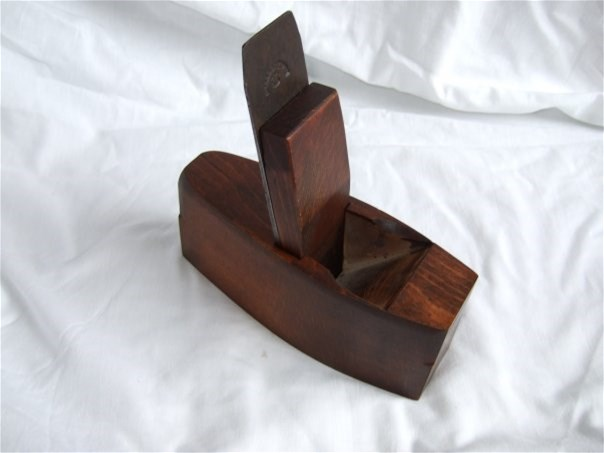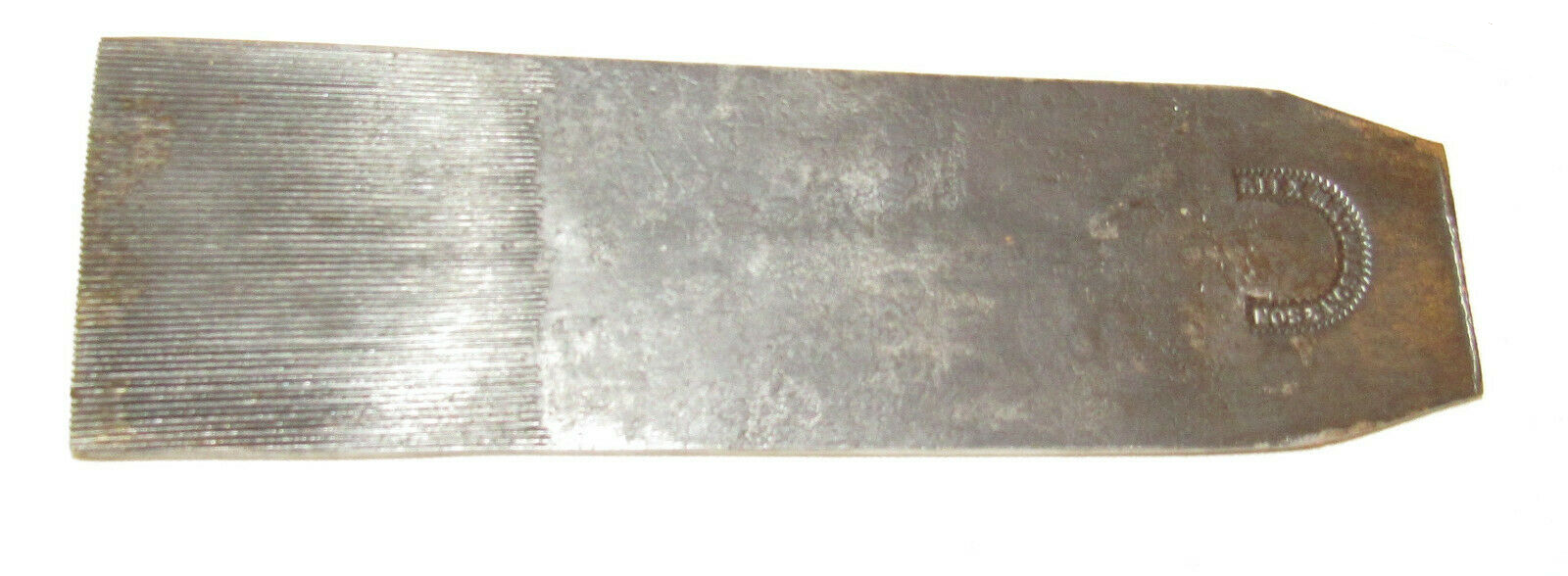Note: This is a classic article from NEWS volume 008, November 1992.
Of all traditional woodworking tools the toothing plane is one of the least understood. In the nineteenth century and earlier it was one of the indispensable tools of the cabinet maker and of the piano case maker. It had a range of uses and offered an efficiency which could not be matched by alternative methods.
Most people think its sole use is to prepare a surface for veneering. In reality this is merely one of its uses. A common prejudice also exists that the toothing plane cannot be sharpened. Let's examine the facts.
 Fig 1: Toothing Plane |
What is a Toothing Plane?
It is a single bladed plane with a high pitched serrated blade. The common form is slightly shorter than a wood smoothing plane, coffin shaped with a blade set at a pitch between 80° - 85°. A second form is Jack size. These are the English pattern. French and German planes have a horned front handle. The blade, or iron, is the most important feature of this plane.
The Toothing Plane Iron
The blade size is in the approximate range of 2" - 2¼". The serration were available in three grades, fine - about 32 TPI, medium - about 28 TPI and coarse - about 22 TPI. The bulk of the iron was of wrought iron with the serrations cut into a strip of carbon steel (cast steel) fire welded to the back. The uses of the various grades will be described later.
Sharpening the Iron

|
There is a belief that the toothing blade cannot be sharpened. Provided it is sharpened correctly it will not tear out the grain. When grinding do not grind to a long level as this will cause the blade to vibrate when cutting and produce a poor surface. Grind at about 30° and hone at 35°. Hone the blade on a fine oilstone in the normal manner. However do not hone the back to remove the burr. The burr can be removed by drawing the edge across the axis of a softwood block. If a fire stone is used to hone the edge will be sharp.
Why Toothing Planes can tear the grain
The cause of this are as follows:
- long grinding level causing weak edge and vibration;
- incorrect lateral adjustment;
- iron set too coarse;
- iron blunt;
- back of iron defective.
Sometimes old toothing irons are found with stress fractures or concave backs caused during tempering. A concave back will of course cause the edge to be advanced ahead of the blade's centre. This will result in torn grain. Mildly concave irons can be honed convex but the real answer is to replace the blade. (Old damaged blades should be kept for their historical value, prefer to use a new blade in my old toothing planes so that the old blades survive for further generations.)
Uses of the Toothing Plane
- Preparing "grounds" for veneering:
The surface to be veneered is prepared with a coarse or medium blade. The use of the plane is not so much to "key the glue" as to remove any irregularities. For large surfaces, e.g. low table tops, the jack size toothing plane is used. Correctly used a toothing plane will produce a truer surface than any other hand or machine method. Edges and end gain to be veneered are also toothed. - Preparing Saw Cut Veneer:
The back of saw cut veneer is dressed with a fine toothing plane. If the veneer has to be thinned down to follow a sharp sweep the thicknessing is done with the toothing plane. - Finishing Veneer:
The surface (or face) of saw cut veneer is finished after gluing down. This is done with a fine toothing plane followed by the scraper. - Finishing difficult grain or very hard woods:
This is finished the same as veneer using first the fine toothing plane and then the scraper- - Preparing large glue surface:
Large laminations are toothed similarly to veneer grounds. - Finishing Shaped Surfaces:
Large shaped surfaces can be toothed to remove plane or shave marks and then scraped. - Finishing knots:
The grain around knots in spruce or fir is often observed to have been toothed. This removed the torn grain and gave a clean appearance. This is commonly seen on old piano cases. - Various uses:
Old pianos show the cabinet makers dependence on the efficiency of the toothing plane. Keys and ivories were toothed before gluing, wild grain braces are often toothed, no doubt to give a quick accurate surface, laminations are toothed, undersides of cases often show tooth makers- If the unseen surface of any quality plane made between 1830 and 1900 is examined, be it Cottage, Upright or Grand chances are virtually every surface will have seen the toothing plane.
Variations of the Toothing Plane
Compassed soul toothing planes were used to prepare “sweeps”.reshaped work for veneering. Badger type toothing planes may also have been made as "one offs" to tooth large rebates or tenons. The toothing iron was often used in the hand to prepare convex shapes prior to scraping.
